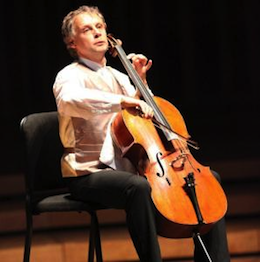
Dutch cellist Pieter Wispelwey will be well in evidence in the city next week, with a free event on Nov. 8 at the Community Music Center, and a special two-part recital of all-Bach unaccompanied cello suites the next day for San Francisco Performances.
The concert and conversation in the Community Music Center's 130-seat concert hall is free and open to the public, courtesy of S.F. Performances.
The Nov. 9 program, in St. Mark’s Lutheran Church, begins at 2 p.m. and will include Suites 1 through 3. The second part, from 7:30 on, presents Suites 4-6. Wispelwey plays on a 1760 Giovanni Battista Guadagnini cello and a 1710 Rombouts baroque cello.
This will be Wispelwey's second appearance here since a recital with pianist Dejan Lazic in 2006. Last year, he celebrated his 50th birthday with a project showcasing the Bach Cello Suites, recording them for the third time.
He recently formed a string quartet, Quartet-Lab, with Patricia Kopatchinskaia, Pekka Kuusisto and Lilli Maijala. Quartet-Lab’s debut project was at the Konzerthaus Dortmund a year ago, and extensive touring is being planned for 2013-2014, including Wigmore Hall in London, Konzerthaus Berlin, Concertgebouw Amsterdam, Schloss Elmau, Helsinki Festival, and Beethovenfest Bonn.
From Jeffrey Johnson's review of Wispelwey's performance at Tanglewood in The Boston Globe:
The joyous G Major and C Major Suites framed the austere Second Suite in D Minor on the first half of the program. Wispelwey took an extremely flexible approach to metric flow in these first suites, often taking long breath pauses to mark phrase endings. His facility masked the digit twisting challenges of the first menuet of the D Minor Suite, and he brought a rustic sound to all three gigues.After the first intermission each suite opened up a new sound world. The Fourth Suite in E-flat Major revealed the pleasures of a sound almost completely lacking open strings. Wispelwey articulated the large-scale rhythmic conflicts throughout this suite, bringing out syncopations, hemiolas, and, particularly in the Courante, conflicts between groupings in two and groupings in three.
He flashed a quick smile as he lifted the back of his left hand during the second measure of the Fifth Suite’s Prelude to sound an open G, he retuned the cello in the short pause between suites, lowering the highest string by a whole step.
This scordatura tuning — an alternate tuning of a string instrument’s open strings — makes a significant difference in sound, particularly in the fugue and the first Gavotte where open strings help shape ideas. Wispelwey played the Sarabande in ghostly non-vibrato anchored by that ringing open G.
The Sixth Suite closed the event with glittering high register playing that Wispelwey made into a culmination. In a surprising move he played only the melody of the D Major Sarabande, playing the chords as written only during the repeat. This allowed us to understand how the simple lyricism of this movement is voiced through struggle and complexity.

